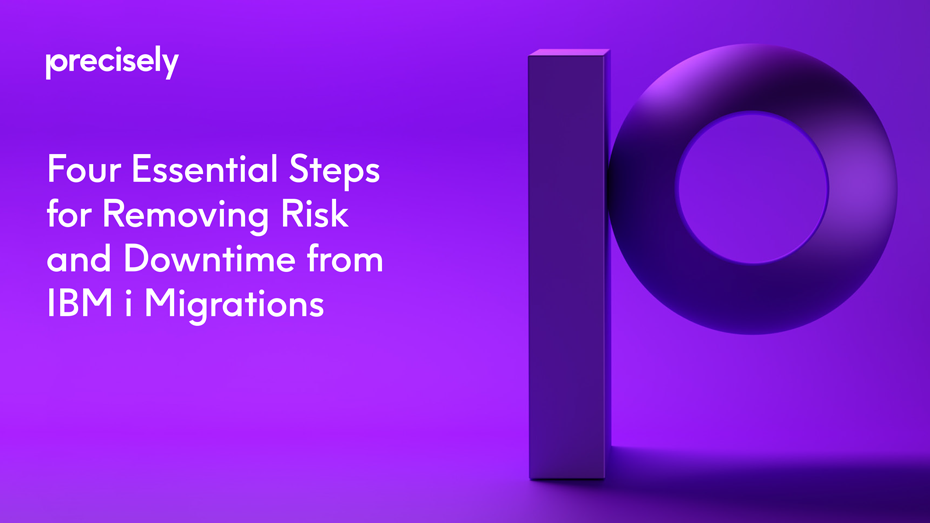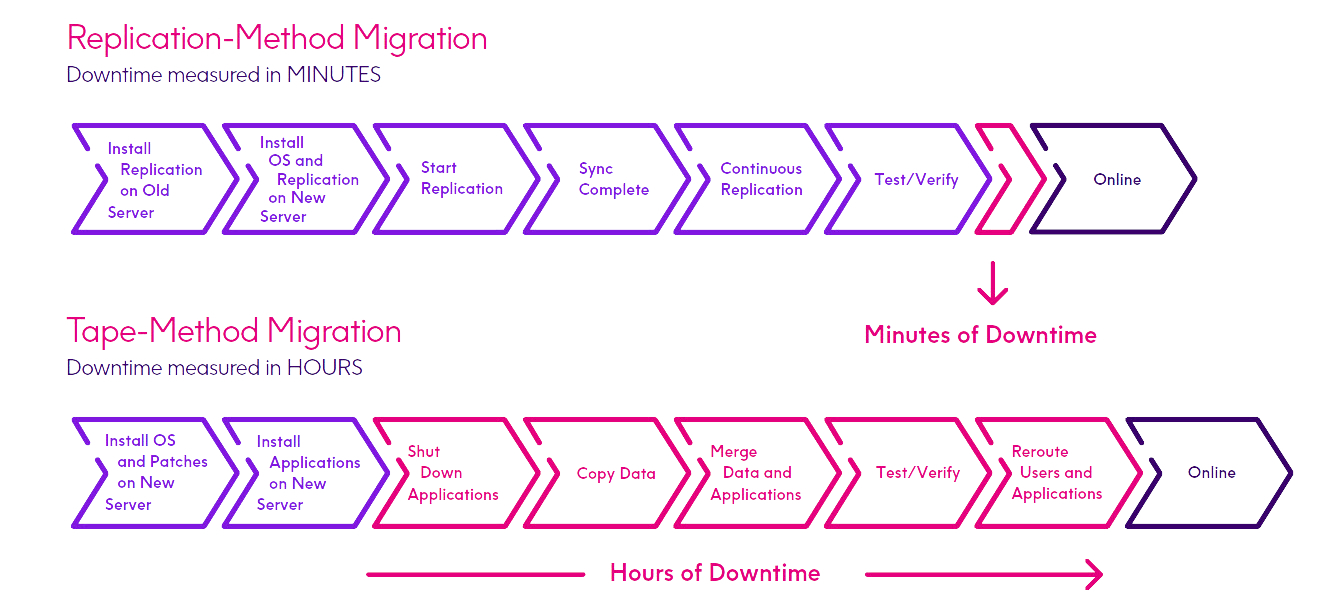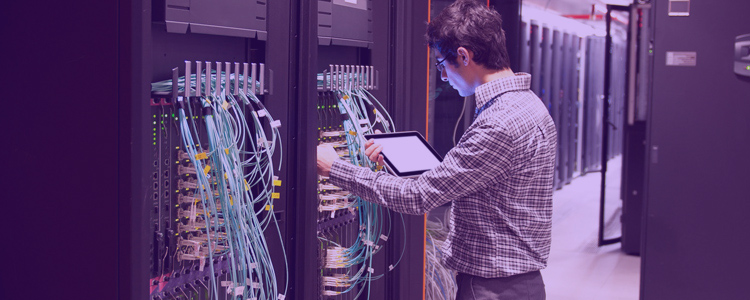eBook
Four Essential Steps for Removing Risk and Downtime from IBM i Migrations
Read this eBook to learn how IBM’s continuous leading-edge engineering and innovation keeps the Power Systems platform at the forefront of enterprise computing performance, scalability, and adaptability. Specifically architected for the most data intensive workloads, IBM i systems combine true enterprise-class processing capabilities with the flexibility of hybrid cloud deployment, including traditional on-premises, private cloud, and public cloud.
Your business must also meet accelerating demands for IT scalability, cloud integration and total security in the face of today’s advanced cyber threats. Which is why you are making the smart choice to upgrade your Power Systems hardware. But before you can start reaping the benefits of IBM’s latest innovations, you must first tackle the challenging process of migrating your existing IBM i data, applications, and system configurations to your new environment.
Migrations always require detailed, coordinated planning and flawless execution. This is especially true today, when downtime of any duration is completely unacceptable. So, above all other considerations, maintaining continuous uptime throughout the process is absolutely mandatory.
This and other concerns about migrations are reflected in the results of a recent Precisely survey of nearly 200 IT professionals who manage IBM Power Systems:
- 60% say they have delayed migrations for various reasons, with the largest reason being concerns about downtime.
- 44% say their previous migration caused six hours or more of downtime (26% say their downtime was longer than 13 hours).
- 46% say they spent 51 hours or longer to plan and execute their last migration (25% say their migration took over 100 hours to plan and execute).
- 31% say they have experienced a migration failure, with the most common cause for the failure being the inability to restart critical applications on the new server within the required timeframe.

Step 01: Assess Project Scope and Prepare for Migration
In any migration, it is critical to thoroughly understand the environment(s) to be migrated. The time and attention invested in pre-migration assessment and preparation, as well as resolution of any potential complications in advance, will pay big dividends during execution. The following are some of the important questions you should ask as you assess your environment and prepare for your IBM i migration:
- Critical objects — Do you know how to identify the critical data and system objects that need to be migrated?
- PTFs — Are your OS patches current on both the old and the new machine?
- Third-party software — Is your third-party software compatible with POWER9? Do you need new license keys in order for those third-party applications to run on the new machine?
- Storage, memory, and processor — How will these resources be allocated on the new machine?
- Interfaces to (or interdependencies with) other systems— Do you understand how these will be affected by the new machine and have a plan to activate them upon “go-live?”
- Security settings — Have you ensured that your environment(s) on the new machine will have all necessary security functions in place to eliminate vulnerabilities at “go-live?”
- Bandwidth — Will the new system require additional bandwidth and data lines? This is particularly important if the new machine is in a different location and when new or expanded cloud computing environments are planned.
- External hardware — Have you verified compatibility of all hardware that will be connected to the new machine (e.g., external drives, communication devices, networking devices, etc.)?
- Backup media compatibility — Will your backup media work on the new machine or do you need to make arrangements to transfer the data to different media?
- External connectivity — Have you assessed how VPNs, FTP, and other types of connectivity will be affected?
- Data preparation/data cleansing — Will you want to find and delete obsolete files and/or do a file reorganization prior to migrating?
- High availability (HA) — Do you have all necessary licenses and settings to start replication from the new machine to your backup system once you cut over?
- Test environment availability and capacity — Do you have sufficient resources in order to perform thorough and deliberate testing of all systems, applications and connectivity without impacting ongoing business operations? Hosting services may provide the best short-term capacity and security options for testing.
- Infrastructure lock — Will you be able to ensure any configuration changes are tightly controlled through a change-management process? This will help minimize surprises after the migration.
- Other considerations — Are there new application versions to consider? Are any new applications being added to the new machine? Is anything being retired before moving to the new machine?


Step 02: Select Your Migration Method
Concurrent with assessing the environment(s) to be migrated, you must also determine how you are going to move the data and other essential objects to the new machine. There are essentially two methods for accomplishing this:
- Tape method — This commonly used migration approach requires doing a full-system save to tape (or virtual tape) backups—and then restoring it on the new machine. Extensive downtime is required with this method, which begins at the start of the system-save process, extending through the restore process on the new machine, and only ending once everything has been configured and tested and users have been allowed on the new system.It’s no wonder that tape-based migrations require evenings, weekends, and holidays to execute and are often plagued by unexpected outcomes. Stress levels climb even higher during the migration should complications arise that further extend the downtime window—as is often the case when tape is involved.
- Replication method — Whether or not you already own a real-time replication solution for disaster recovery or high availability, this technology can be utilized to efficiently synchronize your environment with the new machine without interfering with normal business activity. All subsequent transactions and other activity is continuously replicated in real time to your new machine until you have completed all testing and are ready to make the final switch, which typically requires only minutes of downtime. Replication also greatly simplifies and accelerates setting up a separate, secured short-term test environment.
Compare Migration Methods

Step 03: Create and Execute Your Migration Plan
Once you know the details about the environment(s) to be migrated and have made all necessary preparations, including the selection of your migration method, the next step is to create a migration-execution plan and schedule.
Below is a list of important questions to consider when creating and executing your migration plan. Keep in mind that no two environments are the same, and therefore no two migrations are the same, which is why it’s essential to create a unique plan for your specific environment and needs.
Also keep in mind that what you include in your plan will vary based on the migration method chosen. For example, the questions below that are related to extended downtime and its impact on staff and business operations are primarily a tape-method concern. For a replication method migration, the impacts on staff and operations are dramatically smaller.

- Have you created a detailed migration plan that can be easily followed by your team? Your plan should be in written form and contain as much detail as possible so that there is little room for guesswork. It’s also helpful to write your plan in a way that it can be followed even if you or another key member of the migration team is absent.
- Have you coordinated the migration schedule with other areas of IT as well as line-of-business and other managers? You want to avoid having the migration take place during any times in which there are conflicting priorities.
- Do you have an internal communications plan? Tape method migrations that cause extended downtime require advance notice and clear channels of communication with all affected parties, especially if contingency plans are required to handle prolonged downtime or unforeseen complications.
- Does each person involved with the migration understand and own their part in the migration project? This includes having a clear understanding of the goals, requirements, and potential points of impact of the migration.
- Is extra time built into your migration schedule to deal with the unexpected? When scheduling too tightly, small delays can easily escalate into big problems, especially when doing tape-method migrations.
- Do you have adequate rest periods for the migration team built into your schedule? If the migration requires team members to put in long days, adequate rest periods reduce the chance of staff getting overly tired and making mistakes when the pressure is on. With replication-method migrations, testing can be conducted during normal business hours and the minutes required for cutover can be scheduled at your convenience.
- Have advance arrangements been made with key hardware and software vendors for off-hours support? In case issues arise while these products run on the new machine having access to support could be critical.
- Have arrangements been made for any scheduled jobs that would normally run during the migration? For instance, you want to avoid having an essential, long running maintenance job holding things up at a critical point of the migration cutover process.
- Do you have a plan to ensure any unprinted, business critical spool files (e.g., checks, invoices, pick lists, reports, etc.) are printed before the cutover to the new machine? You’ll want to do this in case something delays the new machine getting online and you can’t roll back to the old machine. This consideration applies only to tape-method migrations because replication-method migrations automatically synchronize all spool files with the new machine.
- Have you run your new IBM i environment for several days before beginning the migration? In the event there are any defective components or other issues, you’ll want these to be discovered well before you start relying on the new machine for production workloads. With replication-method migrations, your new machine can be allowed to run throughout the test period while it is kept synchronized with the old machine.
- Do you have a roll-back plan in case an issue arises during the migration that requires temporarily aborting the migration process and restarting workloads on the old machine? Roll-back plans are mostly needed when doing tape-method migrations. With replication-method migrations, you can do as many tests of the cutover process as you need before the final cutover so you’ll be confident everything will work as expected. And if an issue should arise after final cutover, it’s a quick, simple process to switch back to the old machine.
- Have you validated the plan by distributing it to your team for input? The things that team members point out that weren’t considered in the initial draft of the plan may surprise you. Even better is to have your team be involved in the migration-plan creation process. Also consider bringing in a trusted IT business partner with experience in migrations to review your plan; their extra set of eyes can be invaluable.

Step 04: Test the Migration
Before going “live” with your migrated IBM i environment(s) on your new POWER9 hardware, it is essential to conduct a series of tests to ensure that everything will function as expected.
Based on the migration method selected, the timing of these tests will vary. With a tape-method migration, testing will need to be done during your downtime window. With a replication-method migration, testing can be done during normal business hours without impacting users.
Common migration tests include:
- Connectivity and communications testing — Verify all connected devices and networks are functioning properly.
- Security testing — Ensure all security functions are properly configured. Ideally, this should be done before allowing users on the system or connecting the system to networks, interfaces, external communications, etc.
- Data integrity testing — Confirm the data is in the same state after the migration as it was before. For instance, you may verify that the queries executed on the new database in the new system yield the same results as the older one, and the number of records in the database on the new and old system is the same.
- Application verification testing (AVT) — Test applications to ensure each functions properly in the new environment and, if required, communicates as expected with other systems. AVT also ensures that any new management or monitoring tools have been installed and can communicate with the servers.
- User acceptance testing (UAT) — This test should be completed after AVT by a select number of users to confirm that access to the system and functionality of the applications perform as expected.
All testing should be carefully documented. When issues are found and addressed, testing should be repeated to ensure the problem was resolved. If any of the testing fails, especially if you are doing a tape-method migration, you will need to be prepared to execute your roll-back plan to bring your old machine back online while you re-evaluate your migration process.
Migrate While Active — For Seamless, Low-Stress IBM i Upgrades
Precisely’s Migrate While Active service provides you with an IBM i migration expert who works closely with your team to prepare for and successfully execute your replication-method migration. Utilizing our advanced replication technologies, all required objects, data, and configurations are replicated to the designated environment(s) on your new IBM i systems without downtime.
Once the initial replica has been created, all subsequent changes to data, objects, and settings on the old machine are replicated in real time to the new machine. This dynamic synchronization continues right up until final cutover. During this process, your regular business operations will continue without interruption while your Precisely migration expert works closely with your team to monitor synchronization and facilitate testing using a virtual switch process.
You can take as long as you need to test your applications and other processes on the new hardware, at the new OS level, and in new formats, before ever executing the actual cutover. As you conduct your tests, the auditing capabilities of the replication software automatically verify data integrity between machines.
Only when you are fully satisfied that everything is functioning properly on the new machine will your Precisely IBM i migration expert execute the final cutover process. Typically, any downtime required during the cutover is kept to a few minutes.
Precisely IBM i migration experts bring the combined experience of thousands of migrations, assisting you every step of the way:
- Pre-migration preparation
- Replication software installation and configuration
- Synchronization monitoring
- Verification testing on new system before cutover
- Final cutover to your new system
In addition to the enormous benefit of virtually eliminating migration downtime, Precisely’s Migrate While Active service significantly reduces the work and anxiety that otherwise accompanies the preparation and execution of tape-method migrations. And not only will you rest easy knowing you have a seasoned migration expert assisting you at every step, you and your team will be free to focus valuable time and attention on other IT priorities.

Summary
Moving up to the latest Power Systems capabilities and features is exciting, but the process of migrating to your new machine using tape backup methodologies is not. A backup tape-based method migration is a time-consuming, often-risky process that requires significant planning and preparation, as well as careful execution and thorough testing. Given the extensive downtime this type of migration requires and the complications that commonly occur, it’s no wonder that IBM i shops are looking for a better, more modern alternative such as the kind that Precisely provides with Migrate While Active.
By pairing Precisely’s advanced replication technology with an IBM i migration expert, Migrate While Active dramatically streamlines migration preparation and execution time, reduces risk, and best of all, removes the downtime pain. As the industry leader, Precisely has migrated hundreds of companies and thousands of IBM i environments to new IBM Power Systems hardware. Our experts know how to find and resolve any “gotchas” before they ever become a problem either during or after the migration. Just think of the peace of mind this can bring to you, your colleagues, and your management.